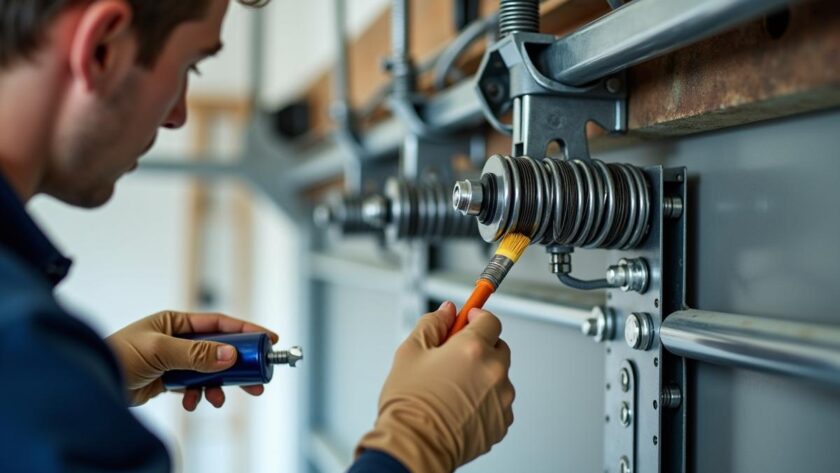To ensure longevity, take proactive steps to prevent garage door springs from breaking unexpectedly. Your garage door relies on these tightly wound coils to function smoothly, and once they fail, the damage can be significant. A broken spring can make your door inoperable and pose safety risks, so a little extra care helps avoid expensive repairs and unfortunate accidents.
Contents
- 1 Garage Door Spring Maintenance Essentials
- 2 How to Prevent Spring Failure Through Inspection
- 3 Boost Garage Door Spring Lifespan with Proper Care
- 4 Effective Techniques for Lubricating Garage Door Springs
- 5 Choosing Quality Garage Door Springs
- 6 Additional Protective Steps to Prevent Garage Door Accidents
- 7 How to Prevent Spring Failure with Smart Choices
- 8 Spring Fatigue and Rust Prevention Tactics
Garage Door Spring Maintenance Essentials
Regular attention to your springs helps ward off sudden failures and extends their overall lifespan. This focus on upkeep is a vital element of proper garage door spring maintenance. By keeping an eye on wear, lubrication, and balance, you encourage the door’s components to last longer and work at optimal performance.
Recognizing Early Damage
Watch for unusual noises, jerky movements, or visible rust—these are common garage door spring problems that often precede a failure. Listen out for loud squeaks or popping sounds, and check if the door becomes harder to open or close. If you notice gaps in the coil, you might be dealing with worn garage door springs that need spring replacement sooner rather than later. Catching these signs early ensures you can address issues before they escalate.
Lubrication Techniques
Lubricating garage door springs cuts down friction and protects against corrosion. Use a silicone or lithium-based grease that won’t attract excess dirt or debris, especially if you live in a dusty region. Apply lubrication sparingly along the length of the coil, wipe away any drip, then test the door a few times to distribute the product evenly.
How to Prevent Spring Failure Through Inspection
Routinely examining the door mechanism keeps you aware of small issues before they become major headaches. A simple garage door spring inspection can reveal signs of rust, cracks in the metal, or coil deformation. Schedule checks around shared conditions like temperature effects on garage springs, since extreme cold can cause metal fatigue more quickly.
Spotting Fatigue and Wear
Pay close attention to loose coils or any visible warping. Both torsion springs and extension springs can experience metal fatigue over time, leading to weakness in sections of the coil. Perform a spring tension testing procedure by carefully raising and lowering the door manually. If the door slams shut or feels off-balance, you may need tension adjustment to prevent garage door accidents in the future.
Checking Door Balance
Door balance goes hand in hand with spring performance. If the door tilts when you raise it halfway, or if one side looks higher than the other, your springs might be unevenly stretched. An unbalanced door adds stress to the entire system, shortening spring lifespan. Minor adjustments to door alignment can often remedy these symptoms and keep everything running smoothly.
Boost Garage Door Spring Lifespan with Proper Care
Preventive measures for garage springs revolve around reducing strain and addressing issues right away. Adding safety cables to extension springs is an effective way to protect against flying debris if a spring snaps. If you use a garage door opener frequently, ensure that its force settings aren’t too high, as that extra force can cause premature wear on the springs.
Regular Spring Replacement Frequency
No matter how carefully you maintain them, all springs eventually need to be replaced. While there’s no hard and fast rule for garage spring replacement frequency, many homeowners find that springs last between seven and ten years. Frequency may vary based on daily use, temperature swings, and even the quality of the springs themselves. When in doubt, consult a professional to confirm when replacement is necessary.
Adjusting Garage Door Tension
Tension adjustment is trickier than it sounds, and miscalculations can lead to broken springs or other damage. If you’re not confident in your DIY garage door spring care skills, call an expert. Still, it’s valuable to understand that too much tension can overexert the system, whereas too little tension makes the door sag and strain the opener. Striking that perfect balance prevents extra stress on the coils.
Effective Techniques for Lubricating Garage Door Springs
Lubrication remains one of the most powerful tools for keeping springs in top shape. It minimizes friction, helps with temperature effects on garage springs, and prevents rust. If you live in a humid climate, take extra care by wiping springs with a rust-inhibiting solution.
Preventing Rust on Garage Springs
Rust acts like a silent killer. It keeps eating away at the metal until cracks or breakages occur. After you clean off old grease and debris, apply a fresh coat of lubricant and ensure each coil is fully protected. Keep an eye out for any rust spots that reappear, as they’re prime indicators of spring fatigue.
Safety Measures and Cables
Even well-lubricated springs can snap under tension if there’s hidden damage within the coil. That’s why garage door safety cables serve as a vital backup. These cables help control the path of a broken spring, reducing the risk of flailing metal that can injure people or damage property. Combining proper lubrication with safety cables provides peace of mind during operation.
Choosing Quality Garage Door Springs
High-grade springs can withstand daily wear and tear better than cheaper counterparts. Choosing quality garage door springs often involves looking at the wire gauge, coil diameter, and the material used. Stronger metal grades hold up better against frequent opening and closing, ensuring a longer garage door spring lifespan increase in busy households.
Professional Servicing
Consulting a professional for garage door maintenance keeps your system running at its best. Professional servicing often includes thorough spring inspection, tension adjustment, lubrication, and door alignment checks. Experts understand the nuances of both torsion springs and extension springs, allowing them to spot small issues or wear you might miss. Through regular checkups, you reduce the chance of broken springs catching you off-guard.
Garage Door Spring Installation Tips
If you’re installing new springs, accurate measurements and proper winding or stretching are crucial. Torsion springs, for example, require precise torque levels to match your door’s weight. Over or under-tightening may lead to early failure. Mistakes here can risk serious injury, so if you’re not comfortable, don’t hesitate to hire a qualified installer with solid spring repair tips.
Additional Protective Steps to Prevent Garage Door Accidents
Even well-maintained springs wear out eventually, but a few small habits can reduce overall strain. Avoid slamming the door shut or leaving it partially open for prolonged periods. Swift temperature changes accelerate garage door spring fatigue, so try insulating your garage if you live in an area with harsh winters or scorching summers.
Monitoring Daily Use
Keep an unofficial tally of how often you open and close your garage door. Heavy usage can prompt more frequent maintenance to keep springs from failing prematurely. When your family uses the door as a main entrance, consider scheduling more frequent spring inspections to keep everything in top shape. This helps you spot signs of problems early, nip potential issues in the bud, and sustain a healthy spring lifespan.
Simple DIY Garage Door Spring Care
While certain tasks like tension adjustment are best left to professionals, there are some DIY steps you can safely handle. Wipe down the springs with a clean cloth to remove dirt, then apply a garage-specific lubricant. Listen to how the door sounds as it opens and closes, noticing any grinding or scraping noise. If something doesn’t look or feel right, get a trusted technician to investigate.
How to Prevent Spring Failure with Smart Choices
What you do during initial setup or replacement tends to have a ripple effect on spring performance. Always opt for springs designed for the weight and style of your door. This specificity ensures that the tension capacity matches the demands of your door system. Pairing the right springs with your door helps prevent garage door accidents and reduces stress on the opener.
Balancing and Alignment Checks
Balancing your garage door is more than a one-time event. Seasonal shifts, metal expansion, and regular wear mean your door’s alignment can change over time. Pay special attention after temperature swings or if you notice a change in how the door moves. Quick adjustments to spring tension can keep the door functioning smoothly without imposing excess load on the hardware.
Avoiding Excessive Force
Your garage door opener should be set to a force level that lifts and lowers the door without straining. An overly forceful opener can slam the door shut and jolt the springs, speeding up wear and tear. If you find the opener straining or producing loud thumps, consider a force calibration to extend the spring lifespan. Small tweaks here can make a big difference in overall spring performance.
Spring Fatigue and Rust Prevention Tactics
Besides lubrication, cleaning off grime or salt residue can help maintain a rust-free environment. If you live by the coast, salty air accelerates corrosion, so more frequent cleaning and lubrication is recommended. For those in colder climates, road salt from vehicles can accumulate on the springs. Wiping them clean significantly reduces the risk of pitting and subsequent metal fatiguing.
Professional vs. DIY Repairs
With the right knowledge, you can handle minor spring maintenance tasks. However, major repairs or replacements call for the expertise of a professional. Attempting advanced tasks without the proper training can cause injuries or damage. If you suspect deep wear or if the door seems uneven even after adjustments, let a qualified technician evaluate the problem for a safer outcome.
Staying diligent about garage door spring care makes operating your door easier and safer. By inspecting for damage, lubricating frequently, and choosing high-quality parts, you maintain a reliable entryway for years. Detailed checks and minor fixes, such as tension adjustments or door balance corrections, help your springs last longer and reduce the chance of sudden breakdowns. A good balance of routine upkeep and timely professional servicing keeps your springs sturdy, preventing unexpected mishaps and keeping your household free from avoidable stress.




